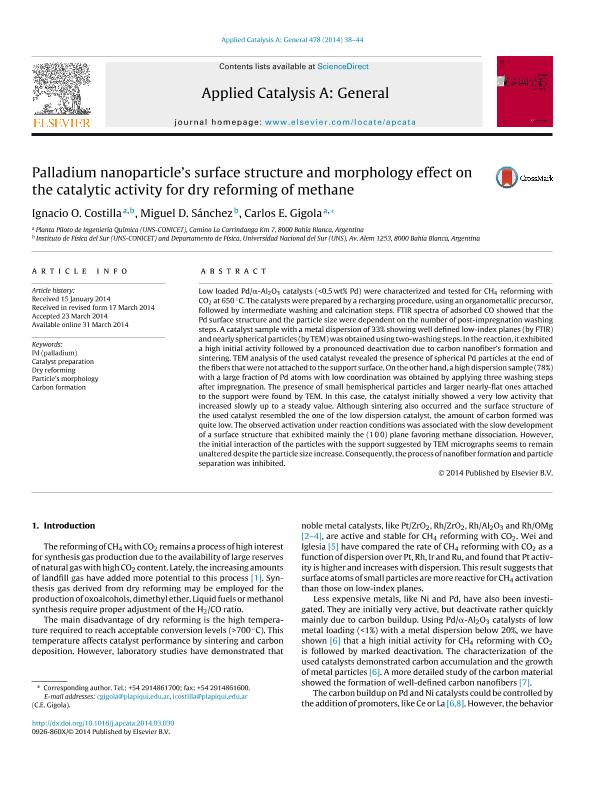Mostrar el registro sencillo del ítem
dc.contributor.author
Costilla, Ignacio Oscar

dc.contributor.author
Sanchez, Miguel Dario

dc.contributor.author
Gigola, Carlos Eugenio

dc.date.available
2019-05-27T21:35:05Z
dc.date.issued
2014-05-31
dc.identifier.citation
Costilla, Ignacio Oscar; Sanchez, Miguel Dario; Gigola, Carlos Eugenio; Palladium nanoparticle's surface structure and morphology effect on the catalytic activity for dry reforming of methane; Elsevier Science; Applied Catalysis A: General; 478; 31-5-2014; 38-44
dc.identifier.issn
0926-860X
dc.identifier.uri
http://hdl.handle.net/11336/77275
dc.description.abstract
Low loaded Pd/α-Al 2 O 3 catalysts (<0.5 wt% Pd) were characterized and tested for CH 4 reforming with CO 2 at 650 °C. The catalysts were prepared by a recharging procedure, using an organometallic precursor, followed by intermediate washing and calcination steps. FTIR spectra of adsorbed CO showed that the Pd surface structure and the particle size were dependent on the number of post-impregnation washing steps. A catalyst sample with a metal dispersion of 33% showing well defined low-index planes (by FTIR) and nearly spherical particles (by TEM) was obtained using two-washing steps. In the reaction, it exhibited a high initial activity followed by a pronounced deactivation due to carbon nanofiber's formation and sintering. TEM analysis of the used catalyst revealed the presence of spherical Pd particles at the end of the fibers that were not attached to the support surface. On the other hand, a high dispersion sample (78%) with a large fraction of Pd atoms with low coordination was obtained by applying three washing steps after impregnation. The presence of small hemispherical particles and larger nearly-flat ones attached to the support were found by TEM. In this case, the catalyst initially showed a very low activity that increased slowly up to a steady value. Although sintering also occurred and the surface structure of the used catalyst resembled the one of the low dispersion catalyst, the amount of carbon formed was quite low. The observed activation under reaction conditions was associated with the slow development of a surface structure that exhibited mainly the (1 0 0) plane favoring methane dissociation. However, the initial interaction of the particles with the support suggested by TEM micrographs seems to remain unaltered despite the particle size increase. Consequently, the process of nanofiber formation and particle separation was inhibited.
dc.format
application/pdf
dc.language.iso
eng
dc.publisher
Elsevier Science

dc.rights
info:eu-repo/semantics/openAccess
dc.rights.uri
https://creativecommons.org/licenses/by-nc-sa/2.5/ar/
dc.subject
Carbon Formation
dc.subject
Catalyst Preparation
dc.subject
Dry Reforming
dc.subject
Particle'S Morphology
dc.subject
Pd (Palladium)
dc.subject.classification
Otras Ingeniería Química

dc.subject.classification
Ingeniería Química

dc.subject.classification
INGENIERÍAS Y TECNOLOGÍAS

dc.subject.classification
Nano-materiales

dc.subject.classification
Nanotecnología

dc.subject.classification
INGENIERÍAS Y TECNOLOGÍAS

dc.title
Palladium nanoparticle's surface structure and morphology effect on the catalytic activity for dry reforming of methane
dc.type
info:eu-repo/semantics/article
dc.type
info:ar-repo/semantics/artículo
dc.type
info:eu-repo/semantics/publishedVersion
dc.date.updated
2019-05-14T21:35:12Z
dc.journal.volume
478
dc.journal.pagination
38-44
dc.journal.pais
Países Bajos

dc.journal.ciudad
Amsterdam
dc.description.fil
Fil: Costilla, Ignacio Oscar. Consejo Nacional de Investigaciones Científicas y Técnicas. Centro Científico Tecnológico Conicet - Bahía Blanca. Planta Piloto de Ingeniería Química. Universidad Nacional del Sur. Planta Piloto de Ingeniería Química; Argentina. Consejo Nacional de Investigaciones Científicas y Técnicas. Centro Científico Tecnológico Conicet - Bahía Blanca. Instituto de Física del Sur. Universidad Nacional del Sur. Departamento de Física. Instituto de Física del Sur; Argentina
dc.description.fil
Fil: Sanchez, Miguel Dario. Consejo Nacional de Investigaciones Científicas y Técnicas. Centro Científico Tecnológico Conicet - Bahía Blanca. Instituto de Física del Sur. Universidad Nacional del Sur. Departamento de Física. Instituto de Física del Sur; Argentina
dc.description.fil
Fil: Gigola, Carlos Eugenio. Consejo Nacional de Investigaciones Científicas y Técnicas. Centro Científico Tecnológico Conicet - Bahía Blanca. Planta Piloto de Ingeniería Química. Universidad Nacional del Sur. Planta Piloto de Ingeniería Química; Argentina
dc.journal.title
Applied Catalysis A: General

dc.relation.alternativeid
info:eu-repo/semantics/altIdentifier/url/https://www.sciencedirect.com/science/article/pii/S0926860X14001835
dc.relation.alternativeid
info:eu-repo/semantics/altIdentifier/doi/http://dx.doi.org/10.1016/j.apcata.2014.03.030
Archivos asociados
